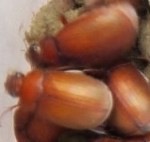 Asiatic garden beetle (AGB) is a native of Japan and China. In 1922 it was first seen in the United States at a location in New Jersey. Although not a significant pest in its native lands, it has spread over northeastern United States west to Ohio and south to South Carolina where it may be considered a serious pest. The larva can cause damage to turf-grass, perennials, annuals, and vegetables by feeding on their roots, while adults attack over 100 species including trees, shrubs and herbaceous plants. The leaves and flowers of some plants like asters, dahlias, chrysanthemums and roses are particularly appealing.
Asiatic garden beetle (AGB) is a native of Japan and China. In 1922 it was first seen in the United States at a location in New Jersey. Although not a significant pest in its native lands, it has spread over northeastern United States west to Ohio and south to South Carolina where it may be considered a serious pest. The larva can cause damage to turf-grass, perennials, annuals, and vegetables by feeding on their roots, while adults attack over 100 species including trees, shrubs and herbaceous plants. The leaves and flowers of some plants like asters, dahlias, chrysanthemums and roses are particularly appealing.
 Description: The adults are cinnamon-brown and about the size of a Japanese beetle. Although the adults are nocturnal they are attracted to light and may collect around lighting fixtures or on window screens. At temperatures of 70o degrees or more they fly to their host plants but walk when temperatures drop below 70o degrees. They may eat irregular holes in plant leaves especially around the leaf margins, or consume whole flower petals. After feeding, females begin to lay eggs in clusters of about three to fifteen in a gelatinous material, preferably in grassy areas. The eggs are buried one to two inches in the soil and hatch in about 10 days. The larvae feed on roots and decomposing organic material and may dig down eight to seventeen inches to survive the winter. They return to the soil surface in spring, pupate for eight to fifteen days, and then dig their way to the surface and emerge as adults. Mature grubs are white with brown heads and conspicuous white appendages (palps) under the head.
Description: The adults are cinnamon-brown and about the size of a Japanese beetle. Although the adults are nocturnal they are attracted to light and may collect around lighting fixtures or on window screens. At temperatures of 70o degrees or more they fly to their host plants but walk when temperatures drop below 70o degrees. They may eat irregular holes in plant leaves especially around the leaf margins, or consume whole flower petals. After feeding, females begin to lay eggs in clusters of about three to fifteen in a gelatinous material, preferably in grassy areas. The eggs are buried one to two inches in the soil and hatch in about 10 days. The larvae feed on roots and decomposing organic material and may dig down eight to seventeen inches to survive the winter. They return to the soil surface in spring, pupate for eight to fifteen days, and then dig their way to the surface and emerge as adults. Mature grubs are white with brown heads and conspicuous white appendages (palps) under the head.
 Control: Hand pick beetles at night using a flashlight or a light trap. Larvae may be limited by repeated tillage in the fall. Insecticides such as Carbaryl, malathion, rotenone or pyrethrins can be used to control severe infestations of adults; Merit applied in early spring will help control larvae.
Control: Hand pick beetles at night using a flashlight or a light trap. Larvae may be limited by repeated tillage in the fall. Insecticides such as Carbaryl, malathion, rotenone or pyrethrins can be used to control severe infestations of adults; Merit applied in early spring will help control larvae.
